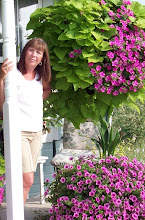
I planted my first wisteria the spring of 2005 and the second wisteria the fall of 2006. Imagine my distress when one spring after another came and went without either vine producing one skimpy bloom. Now, compound that disappointment with a Robinson crabapple and four white dogwood trees that also refused to bloom. The common denominator in this varied problem is cold, wet soil. Phosphorus becomes less available to plants, shrubs, and trees when the soil is clay and the temperatures at bloom time are cold.
The soil on our property is beyond poor. I can dig down two inches and come up with a spade full of orange yuck. When we plant anything, we dig the hole twice as big as need be and back fill it with compost. This gives new roots a chance to get going before they contend with the crud. Unfortunately, new roots have to get there eventually and when they meet the clay, the
 absorption of crucial minerals diminishes.
absorption of crucial minerals diminishes. 





No comments:
Post a Comment